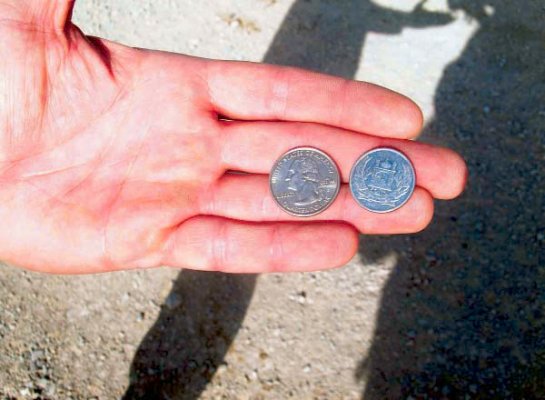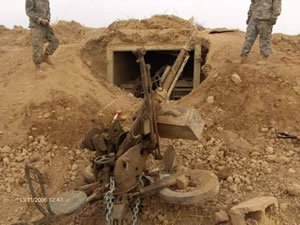
A U.S. quarter and Afghan (2-Afghani) coin were placed side-by-side and
embedded in the last portion of the asphalt.
KANDAHAR AIRFIELD,
Afghanistan – After two years of planning and work, the Kandahar Airfield runway reconstruction project neared completion on Oct. 16.
Army Maj. Paul Graham, the Kandahar area engineer for the Afghanistan Engineer District of the Army Corps of
Engineers, was in charge of this $34 million project.
“It’s like a model car. We got the thing built and now we are putting the decals on it,” said Graham about this five-phase project.
“The project itself started in January 2005. The original runway was built in 1960 by a U.S. contractor and badly damaged in two wars. It was 10,500 feet long by 100 feet wide,” said Graham.
The old runway was completely removed, the underlying gravel base rebuilt, and a new asphalt surface applied,” said Graham. “Kandahar Airfield now has a runway that is 10,500 feet by 180 feet, capable of supporting nearly any airplane.”
“In September alone we worked 84,000 man hours, and our typical crew per day was about 400 people,” said Graham about the great deal of manpower used to complete this project.
About one-third of workers were Afghans, while the rest were from a Turkish paving company and Contrak
International Inc., a U.S.-based general contractor.
Air Force Capt. Michael Scullion, civil engineer with the 17th Civil Engineering Squadron and runway project liaison,
explained how the improvements on the runway will benefit the basic maintenance of the aircraft.
“The old runway was a constant foreign object damage hazard. This new runway will help Coalition forces decrease maintenance on their aircraft. Before, crews were out there, a big part of their day, repairing the engines due to FOD,” said Scullion.
“Harriers just hammered the old runway with their downward jet blast. They literally blew the old runway to pieces. Air Force engineers worked tirelessly to keep the old runway operational until phase three was completed,” said Graham about the usage of the runway.
Many Coalition forces didn’t fly into KAF because no nation wanted to risk damaging their aircraft on bad asphalt.
“For FOD, the F-16 Falcon is a vacuum cleaner,” Graham added. ”It sucks up dirt, dust and debris off the ground better than just about any other aircraft. The old runway was broken up to the point where if you operated an F-16, it would suck up chunks of the runway.”
Now, KAF has a runway with the capacity for longer-range fighter aircrafts, bigger cargo aircrafts and commercial airliners, supporting aircrafts that previously could not operate here.
“We are already seeing the commercial cargo outfits such as DHL and ACT flying bigger birds into KAF,” said Graham. “We’re all waiting to see that first C-5 Galaxy or L-1011 TriStar come in on final.”
While NATO-ISAF forces will certainly benefit from a larger runway, perhaps the greatest impact of this airfield runway reconstruction project will be how it helps the people and economy of the region.




TIKRIT, Iraq – Task Force Lightning Soldiers from 3rd Battalion, 1st Brigade, 5th Iraqi Army, and the 5th Squadron, 73rd Cavalry Regiment, 82nd Airborne Division, dealt a blow to anti-Iraqi forces by killing nearly 50 insurgents and capturing 20 while uncovering a large cache complex.
During this combined operation, Task Force Lightning Soldiers from the IA and coalition uncovered six caches, many of which were buried in underground bunkers. The caches included over 400,000 rounds of small-arms ammunition, 15,000 rounds of heavy machine gun ammunition, five mortar bipods, three heavy machine guns, three anti-tank weapons, two recoilless rifles and numerous mortar rounds, grenades, flares and artillery rounds.
Additionally, the Soldiers noticed an abandoned Nissan truck with false license plates. Upon searching the vehicle, the Soldiers uncovered a number of IED making material and anti-Iraqi forces items such as batteries, cellular phones, blasting caps, explosives, propaganda materials and a large amount of U.S. dollars.
“We made a significant impact on the enemy’s ability to conduct any type of anti-Iraqi force operations,” said Lt. Col. Andrew Poppas, 5-73rd commander.
Elements of the 3/1-5 IA, and 5-73rd Cav., conducted the five-day mission, engaging insurgents while emplacing IEDs in the roads or maneuvering in tunnel and canal systems, staging for attacks.
Aside from the impact on the enemy’s stronghold, members of the unit also conducted engagements throughout the surrounding villages.
“At the same time, while we are having these direct kinetic operations, we are having non-kinetic engagements with the families of the village who also want the insurgents out of their area so they can return to a sense of normalcy,” Poppas said.

HOOAH!!!
The untold story, of support troops like the Air Force and Army engineers building runways for aircraft needed in the war effort. This runway will save lives of Americans, Allies and Afghans.
Another untold story. US and Iraqi Army troops conducting successful operations to seek out and kill/capture terrorists and their supplies. If only our circus of political “eaders” functioned half as well as our military.
Yankeemom I love your HOOAH!!!!
Big ole smile!
They sure are untold stories I agree Tom. You know I don’t find them at regular sites online. I go to military sites where they have press releases and why for the life of me can’t the media tell these stories when they are actuall press releases for anyone. NO the meida would rather tell us about stupid Tom Cruise etc. sheesh!
Thanks Tom.